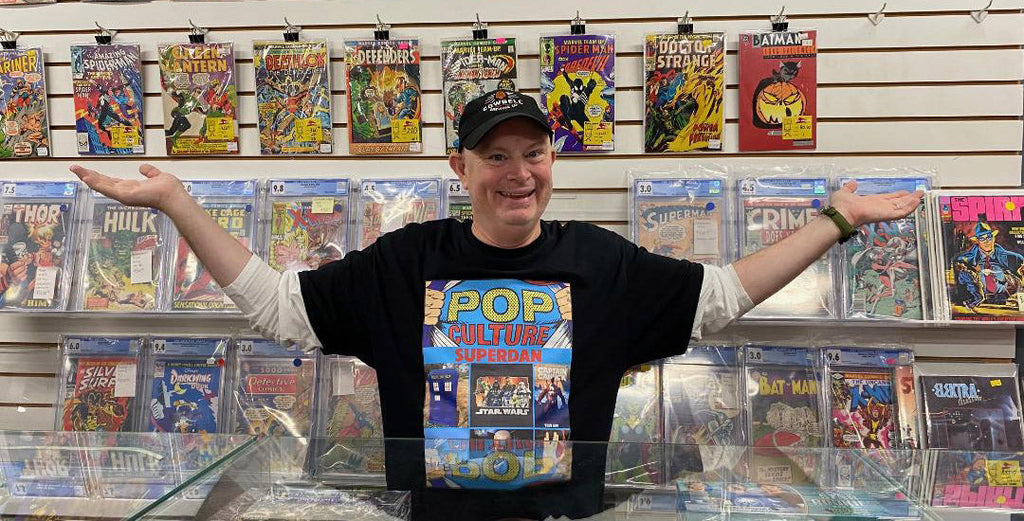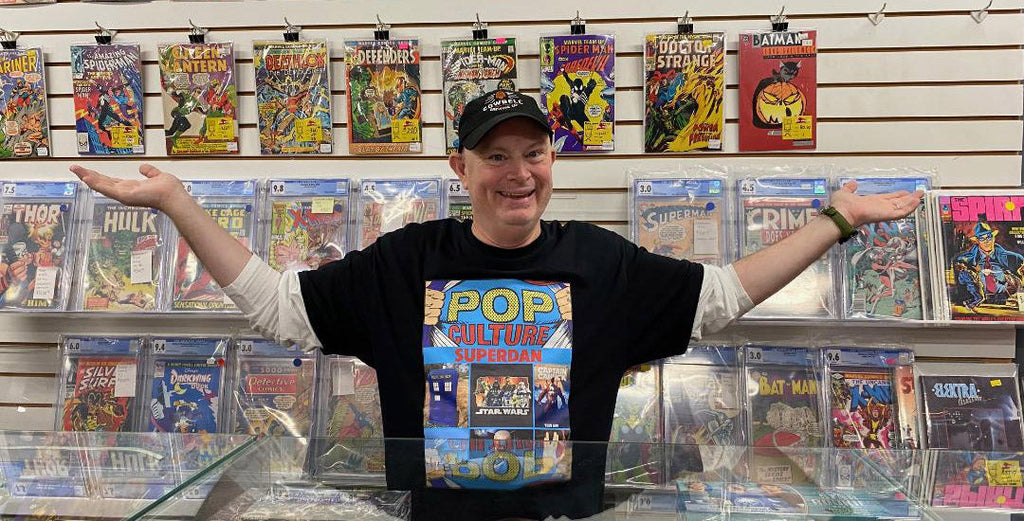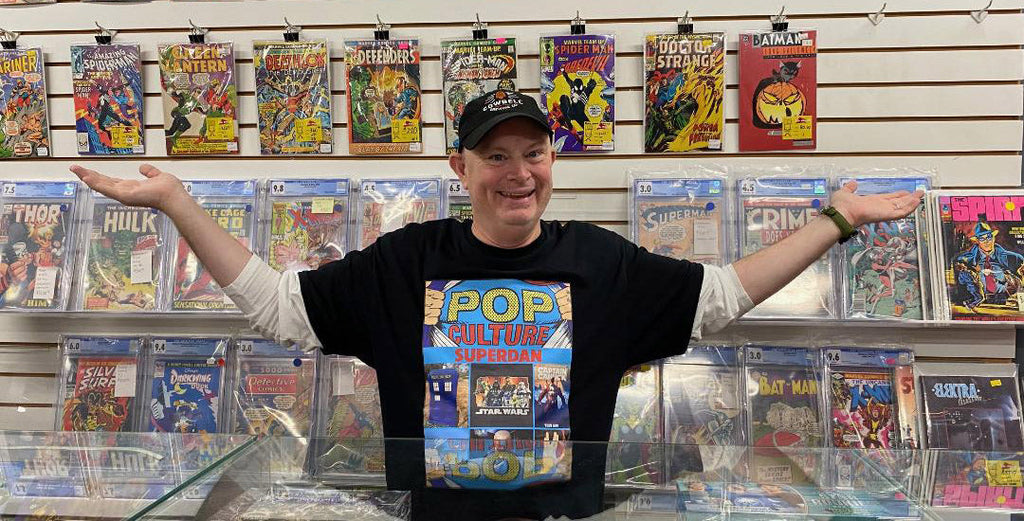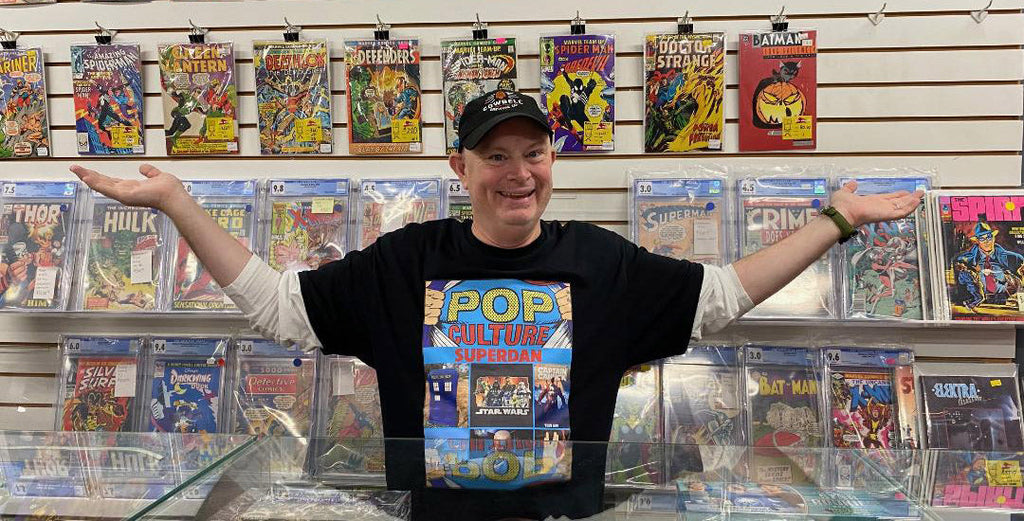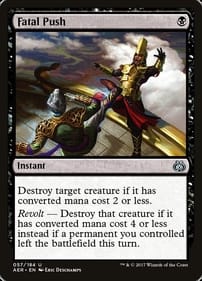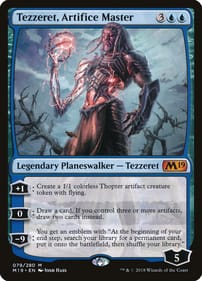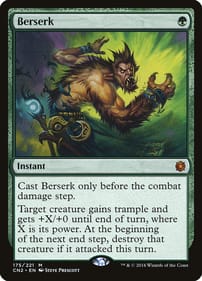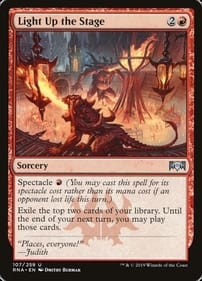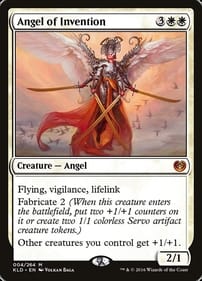Here’s a Bunch of Mini-Reviews
By Dan Brown Here’s the lowdown on a stack of comics I bought recently. There’s no logic to the choices, other than each cover struck my fancy while I was browsing the new-releases wall at L.A. Mood. Fantastic Four No. 29: Perhaps I have a case here to sue Marvel for bait-and-switch. I picked this one based on the cover, which promises an out-of-continuity tale answering the question, “What if . . . Mickey & friends became the Fantastic Four?” I was intrigued by the idea of Goofy switching places with the ever-loving Thing. As it turns out, it was a variant cover. Instead, I got a Ryan North/Cory Smith joint titled The Dream Team about Doctor Doom taking over . . . everything. This looks to be Marvel’s event series this summer, One World Under Doom, and I applaud the House of Ideas for taking this one on, if only because they are going to get so much blowback from Trump fans claiming it’s a metaphor for the current situation in the U.S. The FF goes to bat for the downtrodden . . . who in this case are vampires left over from the previous event series. Doctor Doom & Rocket Raccoon No. 1: I love the movie Rocket more than the comic Rocket, so in my mind I read his dialogue in Bradley Cooper’s voice. I haven’t read a J. Michael Straczynski-penned story in a long time, and this one is long on philosophy, short on action. Doom partners with the genetically engineered rodent to help him delve into the origins of . . . everything. Essentially, the Latverian ruler wants to travel back in time to a time before time. That is, before the Big Bang. I give Doom props for recognizing that a lowly raccoon is almost his mental equal. And one page features a Jack Kirby-esque collage, which is a bonus. What do they discover in preshistory? “The purpose of the universe is to understand the purpose of the universe.” It’s one of them paradoxes. Godzilla vs. Fantastic Four No. 1: This is easily the best-illustrated issue among my purchases, featuring John Romita Jr. art based on a Ryan North script. Marvel takes the existing Marvel continuity and fuses it with the Toho storyline, as happened with the original Marvel series about the fire-breathing unfrozen dinosaur. Reed even tips his hat to Dr. Daisuke Serizawa’s oxygen destroyer in the opening panels. One cool concept in this issue sees Godzilla foe King Ghidorah taking on the power cosmic in his role of herald of Galactus. And yes, it’s all leading up to an eventual battle between the Tokyo-demolisher and the world-devourer. Godzilla Heist No. 1: If you’re a fan of Godzila, this is truly an awesome time to be alive because you can read about him in more than one company’s comics. This IDW-published series reads sort of like what would happen if Quentin Tarantino directed a kaiju flick. As powerful as Godzilla is, here his rampages are just a massive distraction for a ring of human thieves who, naturally, don’t know which one of them might betray the others.The story begins with the big G destroying a casino, which is certainly one way to make sure the authorities don’t pay attention to your scheme to plunder their treasures. Godzilla vs. Chicago One Shot: As part of the Godzilla vs. America series, local creators get a stab at fitting Godzilla into their own community’s neighbourhoods, politics, and culture. Also part of IDW’s current offerings, it’s really just an excuse to pay tribute to old-school comic sound effects such as:Dong donk!Zang!Zong!Choom!Fwomp! Fwooosh! Shreeonk!What can I say? I know what I like. Daring the Sun No. 2 by Forest City creator Scott Brian Woods: Called Crash Down, this tale of an astronaut traveling through the heart of a sun is “inspired by imagination comics of the past, science fiction, and a deep love of old-school adventure, sci-fi fantasy space operas.” The Kirby Crackle on the opening splash page jumped out at me, and the drawing on the back cover shows the pilot in a Flash Gordon-esque outfit with an old-school raygun. Somehow, he is connected to a warrior named Vala, who fends off dinosaur-like aliens in a barren landscape. If you like classic George Lucas intercutting, you will love the structure of this piece, ending naturally with a cliffhanger. Moon Girl and Devil Dinosaur 10th Anniversary Special No. 1: I don’t know how, exactly, Lunell Lafayette got a hold of the ultimate nullifier, but it’s one of the items she brings to her surprise 10th birthday party in New York. A back-of-the-book story flashes forward to when Moon Girl has grown into Moon Woman, and she visits Earth from the orbiting satellite. Senior Marvel Editor Mark Paniciccia says the series has lasted a decade because “it’s inspired young readers to embrace their individuality and believe in their potential.” Or maybe they just really like to groove on the blood-red T-Rex who is Moon Girl’s constant companion. What comics or graphic novels have you been reading lately? I’d love to hear about it in the comment box below! Dan Brown has covered pop culture for more than 32 years as a journalist and also moderates L.A. Mood’s monthly graphic-novel group.
Comic Writers Are the New Auteurs
By Dan Brown My brother Mike is four years older than me, but as kids we were both fans of Marvel Comics. One time, it might have been while I was reading an issue of Fantastic Four and he was perusing the latest Marvel Team-Up, he asked me a question. “Do you think the writer of a comic or the artist is more important?” For me, the answer was obvious: The person who draws the pictures. Not surprisingly, Mike disagreed, arguing the guy responsible for the words has primacy. That exchange has stuck with me to this day. Perhaps I was so adamant as a young boy because I had done more drawing than writing. My perception was that artists got no respect then, and I still believe that today. This is just a long-winded way of saying, in the modern comic industry, writers are the new auteurs. Illustrators, meanwhile, aren’t appreciated for everything they bring to the table. “Auteur” is a term borrowed from French New Wave cinema. I believe it originated in the French film magazine Cahiers du cinema in the 1950s Basically, auteur theory – as it applies to film – dictates that the director of the film is the one who supplies the overall vision. He or she is the “author” of the movie and the other folks involved – producers, screenplay writers, performers – are there to carry out his or her goals. It was a revolutionary idea decades ago. Today’s auteurs would include the likes of Christopher Nolan, Martin Scorcese, and James Cameron. They’re the ones who move the art forward. Somewhere along the line over the last five decades, writers have emerged as the equivalent figure in the comics industry. When I was reading Fantastic Four in the 1970s, I don’t remember comic fans talking a lot about the styles of different writers, but I do recall many debates about the best illustrators. In 2025, however, the conventional wisdom is that the writer is the one whose ideas and input count the most. On the cover of a typical mainstream comic, it’s the writer’s name that gets top billing. Often it’s just his or her last name – that’s how much recognition they get, how well-known they are. When comic publishers promote a new series, it’s frequently marketed to the public on the strength of the writer’s reputation and ability. I don’t know the exact moment when writers ascended to the level of being auteurs. I’m guessing it had a lot to do with three comics that came out in the 1980s: Alan Moore’s Watchmen, Frank Miller’s The Dark Knight Returns, and Art Spiegelman’s Maus. Many fans, as well as industry insiders, view that period as a renaissance when new life was breathed into the form. The guys involved became giants. (If you want to laugh at a savage satire of Moore in particular, check out Chip Zdarsky’s Public Domain series, which has a British comics writer character named Carter Dusk, who hangs a garden hose in front of the window in his study so he can brood as it’s raining all day long. In his own pretentious words, Dusk is a “dabbler in wordplay and mass-printed magic.”) You might think the passing of the years has softened my stance. Not so. I still think artists don’t get the props they deserve. I don’t know about your buying habits, but I usually pick up a comic or graphic novel based on who did the art. Since I first began to appreciate sequential storytelling, the art in the average comic book has gotten so much better. Yet I don’t see anyone arguing in 2025 that the same has happened to the writing. Or consider this: There are many artists who have branched out into writing, sometime Canadian John Byrne being one example. Artists like Byrne have been able to learn to do plotting, dialogue, pacing, and everything else writers have traditionally done. But can you think of a single instance of a writer learning how to draw? It just doesn’t happen. I would love to read your answer to the question my brother posed all those years ago. Feel free to drop it in the comment box below! Dan Brown has covered pop culture for more than 32 years as a journalist and also moderates L.A. Mood’s monthly graphic-novel group.
Read Local, Shop Local, Attend Local Cons
By Dan Brown I’ll be honest with you: I don’t know how the Trump tariffs are going to affect the price of comics, if at all. But if you’re looking for ways to put your comic-book dollars back into the local economy, be it Southwestern Ontario or Canada, here are a few ideas for how to do so. For starters, you can patronize local comics stores like L.A. Mood, which employs Londoners and supports the local pop-culture ecosystem by hosting events like Godzilla Day. The Forest City has always been blessed with more than its share of places where you can pick up your favourite comic titles, and the same goes for all of Southwestern Ontario. Here’s a fun road trip idea for when the warm weather arrives: Make it your goal to visit all the comic stores in this corner of Canada, which will mean travelling to such communities as Sarnia, Windsor, Chatham, Kitchener, and Guelph. I did so a few summers back and it was a blast! Along the same lines, when convention season starts back up, you don’t need to go all the way to San Diego (or even Toronto) to hang out with other comic enthusiasts.London has cons aplenty, including Forest City Comicon – which this year moves to a new date (November 2) and venue (the Lamplighter Inn). Other shows to keep in mind include the Chatham Kent Expo, which happens April 26 and 27. I realize bigger cons get bigger names. That doesn’t necessarily make for a better experience, though. For example, almost every DC or Marvel panel I’ve attended at Fan Expo in previous years can be summed up in one sentence: “Our company has such cool stories coming out soon, but if we told you the details it would spoil them.” The difference at a smaller event is the friendlier vibe, which is much warmer. There is no substitute for meeting comic fans or cosplayers in your own backyard! And what’s that, you say you also want to read local at this moment in our country’s history? It’s easy to make that happen by throwing your support behind specific creators and publishers. There are guys like Byron’s Derek Laufman, the graphic novelist responsible for Bot 9, RuinWorld, and Crimson Fall. Fans can buy his books and art directly from his website. Laufman also has a Patreon page, which offers exclusive first looks at the projects he is working on. Other Forest City creators to check out include Diana Tamblyn, A Jaye and Alison Williams, Scott MacDougall and D.S. Barrick (who publish under the banner of River Donkey Adventures), Sam Maggs, and don’t forget Bryan Lee O’Malley. Among the cartoonists with connections to the wider Southwestern Ontario scene are Jeff Lemire, Seth, Scott Chantler, and Joe Ollmann. Or perhaps you want to support Canadian publishing houses. Done. There’s always Drawn & Quarterly in Montreal, the East Coast’s Conundrum Press, and Chapterhouse Comics (the publisher of Captain Canuck). They all do compelling work. If you don’t like my ideas and you need more suggestions, just consult with the staff at your comic-store or the nearest librarian. When it comes to comics, and pop culture in general, our dominion punches way above its weight. So if you have any other suggestions of other creators to support, or different ways to keep your pop-culture dollars circulating close to home, I would love to hear all about them in the comment box below! Dan Brown has covered pop culture for more than 32 years as a journalist and also moderates L.A. Mood’s monthly graphic-novel group.
Captain Canuck is the Right Hero, Right Now
By Dan Brown This is my love letter to Captain Canuck, who in 2025 celebrates 50 years of battling aliens, evil businessmen, radiated monsters, neo-Nazis, and street-level crooks in the True North. First appearing in 1975, Canuck has had a sporadic publishing history in the decades since but that didn’t stop the superhero from making a deep impression on me, as well as an entire generation of young comic fans in Canada. I came on board when issue No. 4 showed up on the spinner rack in the variety store at Westown Plaza Mall (now Cherryhill Village) on Oxford Street. That would have been 1979. Captain Canuck co-creator Richard Comely, who still appears at fan gatherings (most recently Toronto Comicon last weekend), has said the red-and-white-costumed do-gooder filled a niche that Marvel and DC weren’t addressing back then. When I close my eyes and think about the Canuck of my childhood, what jumps out at me is . . . the colour. Captain Canuck popped off the page. It was the first comic I had found in which the skin of white characters wasn’t a flat pink; it was pink mottled with all kinds of purples and reds. And I wasn’t a kid who read comics for the colouring or quality paper. Yes, I was also a fan of Wolverine over in the pages of the Uncanny X-Men. But there was something about Canuck. Perhaps it was his modest powers – Tom Evans, struck by an alien ray, gains the strength of two, count ’em two, mortal men. Logan may have been an unstoppable killing machine, but Canuck was a real Canadian in that he was much more modest and realistic. I grasped that, even as a kid. Even the odd touches wormed their way into my imagination. When Canuck is imprisoned by the underlings of the dastardly Mr. Gold in that fourth issue, he does what any superhero would do: He prays to God for help. In the ensuing panels, he spots a loose brick in the cell he’s housed in, and targets it to gain back his freedom. I also loved the science-fiction look to the whole thing. Captain Canuck took place in the futuristic world of the 1990s, when Canada has fulfilled Wilfrid Laurier’s prediction that it would own the 20th century by becoming the most important country on the planet How important was Captain Canuck? So much so, his series was the only one I got a subscription to, that’s how much I loved the George Freeman-drawn action. I couldn’t chance missing even one issue. Smarter people than me have pointed out how Canuck seems to have a sense of occasion, with his 50th birthday coming at this particular moment in our nation’s history, when the U.S. president has been musing aloud about his wish for Canada to become part of the United States. Comely has seized on the revulsion many Canadians are feeling right now, offering a variant cover with Canuck telling Donald Trump firmly to back off – not by smashing him in the mouth, just forcefully squeezing his arm. Another cover on offer at Toronto on the weekend by Ty Templeton goes a step further, showing a reluctant Canuck giving a solid punch to Uncle Sam. “Please don’t make me fight you!!” he pleads as he lays out the star-spangled symbol of the American people. Since those early days, there have been several different versions of Canuck. The character got stranded in the past just as the series went on hiatus, leaving us diehards moping about the fate of our favourite homegrown hero for decades. But he came back, keeping the faith with his now grown-up fans who still remember the glory days. Captain Canuck had originally appeared in the Me Decade in the afterglow of Canada’s year-long centennial celebrations. The hardscrabble 1970s, a decade of disillusion, brought Canadians back to Earth. Canuck captured our hearts with his essential decency – even in the future time of 1993, Canadians were still the envy of the world, fighting for decency, using their influence to forward the cause of goodness. So maybe his 50th anniversary is coming at just the right moment in the history of our dominion. Perhaps everyone here and abroad needs a reminder of all the good things Canada has brought, and continues to bring, into this world. That’s why Captain Canuck is always the right hero at the right time. Dan Brown has covered pop culture for more than 32 years as a journalist and also moderates L.A. Mood’s monthly graphic-novel group.
New Comic Back Issue Collection Available Starting Saturday, March 8
A new back issue collection available starting Saturday, March 8 at 10 AM. Eight plus boxes of new back issues! Highlights include CGC graded and ungraded early Amazing Spider-Man, a near complete run of TMNT (Mirage) and more! This collection will be available in store and the following week select comics will be added online. Visit early for best selection! Watch for future emails and Facebook posts for more reveals. See below for a sneak peak! See the collection in person. Collection drops Saturday, March 8, 10 AM. L.A. Mood Comics and Games100 Kellogg Lane, Suite 5, London ON N5W0B4
New Star Wars Comic for Fans Only
By Dan Brown Although it’s well-made, Star Wars: A New Legacy No. 1 will likely appeal mostly to diehard fans of the interstellar epic. If you’re a devotee of characters like Valance, Black Krrsantan and Doctor Aphra, this is the comic for you. The presence of heroes from the movies – Luke Skywalker, Princess Leia, Han Solo – is felt here, but those old favourites aren’t actually part of the action. Instead, this comic contains a trio of tales which were created as vehicles for minor players in Marvel’s Star Wars universe. As Marvel begins a new phase of its Star Wars offerings, they’ve been promoted. Some members of this introductory issue’s cast have a long history. Valance, for instance, originated way back in 1978 in Star Wars No. 16. He was introduced as a self-loathing cyborg, which seemed to be a Marvel specialty back then – the publisher also had Deathlok on its roster in those days. This was years before Star Wars fans got a peek under Darth Vader’s helmet in The Empire Strikes Back. However, there’s no sign of Jaxxon, the giant green alien rabbit, who has gone from being a bad joke to beloved by fans. Hey, if people today can openly express their love for Jar-Jar Binks, then anything’s possible. Marvel got the rights to print Star Wars comics when the original movie debuted in 1977. It was an astute move, as some observers credit that title alone for keeping the company solvent in a financially precarious era. It’s hard to believe now, but over the decades the space fantasy’s appeal faded, so Dark Horse Comics eventually became the official headquarters for Star Wars comics. When Disney brought Marvel under its corporate umbrella, the licence soon reverted back to the House of Ideas. In the first section of A New Legacy, Valance appears on the trail of Doctor Aphra.For years, I wanted to see a Disney+ series featuring Aphra, but my prediction that the gonk droid would get a show before the rogue archeologist seems less and less like hyperbole as Aphra continues to go unloved by the Star Wars brain trust. Even one of her sidekicks, the wookiee called Black Krrsantan, made the leap to the small screen in the Book of Boba Fett without Aphra. She also appears in the back-of-the-book section in a story that inverts the old saying about letting the wookiee win at holographic chess. It turns out that advice doesn’t apply when one of the big, shaggy aliens is playing against a murder robot: “Let the droid win.” Sandwiched between those two stories is a narrative about the Empire’s Scar Squadron, who are also known as Task Force 99. This tale has a slight flavour of the Wild Bunch in that these stormtroopers are men out of time – they embody everything Imperial at a moment when the Rebellion is on the rise. They can’t understand why the crowds that used to cheer them want to rise up at the urging of rebel scum they consider terrorists. “We bring order, while all they have to offer this galaxy is chaos,” their sergeant laments in his inner monologue. This means the white-armoured soldiers – who operate on the outer rim of the outer rim – are on their way to becoming like the U.S. commander in Vietnam who famously said, “It became necessary to destroy the town to save it.” These grunts are on their way to setting fire to the universe so they can preserve it.Every Star Wars buff has their own favourite obscure characters from the vast universe created by George Lucas. If the one’s I’ve mentioned here are among yours, then you’ll enjoy A New Legacy. If not, you’ll want to give it a miss. Dan Brown has covered pop culture for more than 32 years as a journalist and also moderates L.A. Mood’s monthly graphic-novel group.


